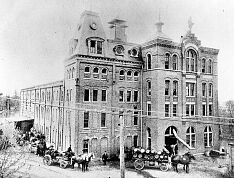Structure reflected county's development
It went from outpost to bustling community.
By Kevin Kilbane
of The News-Sentinel
 |  |  |  | News-Sentinel photo by File photo
| | Centlivre BreweryCentlivre Brewery, founded by immigrant Louis Centlivre in the early 1860s, was one of the Midwest's major beer producers by the 1870s. The company's teams of draft horses were well-known throughout town; residents would stop and watch as the teams hauled beer wagons from one saloon to the next. |
|
|
The community that built the Allen County Courthouse did so based on its proud heritage of progress and with an eye on becoming a major commerce center in the Midwest.
People felt tremendous pride in having built the community from a wilderness outpost to a prosperous city, said Donn Werling, executive director of the local History Center historical museum.
"It (the courthouse) is an expression of success, achievement, repose and beauty," Werling said. "All things were going to be possible."
Indeed, the city had seen its population jump by nearly a third to 45,115 between 1890 and 1900, Bert J. Griswold wrote in his book "The Pictorial History of Fort Wayne, Indiana."
Fort Wayne stood at the crossroads of several rail lines, making it an appealing location for industry.
By the 1870s, Centlivre Brewery, which immigrant Louis Centlivre founded here in the early 1860s, had become one of the major beer producers in the Midwest, historian Michael Hawfield wrote in "Here's Fort Wayne: Past and Present." Large woolen and knitting mills, such as Wayne Knitting Mills, employed hundreds of people and marketed products nationally, Hawfield said. Jenney Electric Co. was a pioneer in the field of electric lighting.
Beginning in late 1901, the city also became a hub for electric, interurban rail service.
"The coming of the electric interurban railway made Fort Wayne an important center of passenger and freight traffic in the Middle West," Griswold wrote.
The city also had developed culturally.
In 1893, the City Council voted to allow the Women's Club league to set up a public library in the City Building, Griswold wrote. The library opened in 1894, the same year the local Young Women's Christian Association (YWCA) was founded.
The Fort Wayne Kekiongas played in the nation's first professional league baseball game in May 1871, Hawfield said. Robison Park, a center of community recreation, opened north of the city in June 1896.
Constructing such an inspiring building also fit in with the City Beautiful movement then sweeping the country. Community leaders believed creating a beautiful city would enhance the moral and spiritual character of its residents, reports say.
Thus, the new Allen County Courthouse, dedicated in September 1902, would not only reflect Fort Wayne's dramatic transformation from wilderness post to progressive city. The grand building also would be a sign of the national stature community leaders hoped the city would attain in the future.